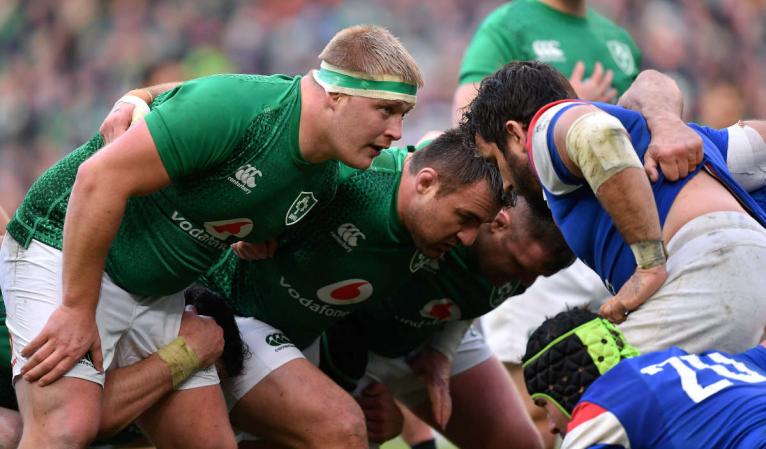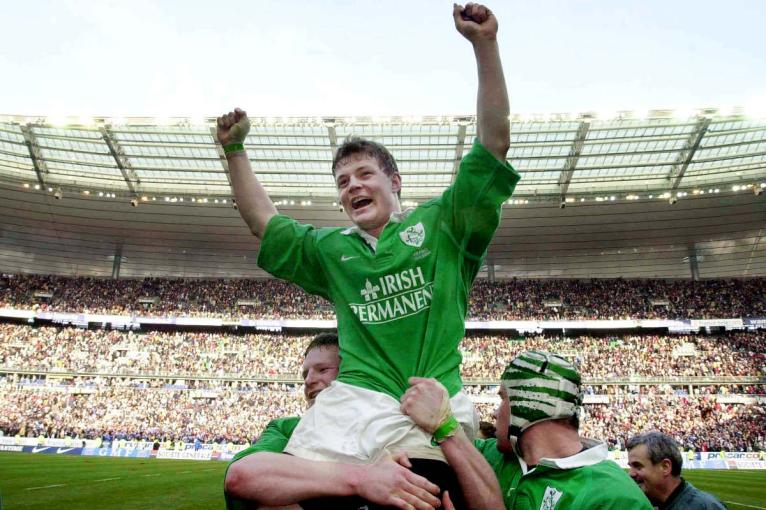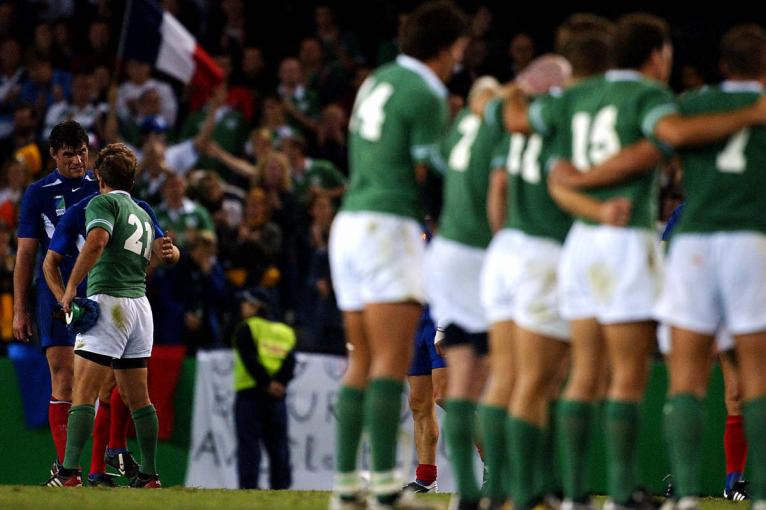He walked into a team room populated by All Blacks when something weird happened. Players that he has respected throughout his career stopped what they were doing to come across and introduce themselves.
There was something about their humility that made him feel at home, even if home was 18,000 miles away. John Ryan, the 24-times capped Ireland tighthead, newly arrived on a one-year contract, was fighting jet lag when he first stepped through the door of the Chiefs’ training centre.
They were gearing up for the start of the 2023 Super Rugby season, the end of summer in Waikato, the beginning of the Indian Summer in 35-year-old Ryan’s life. “I didn’t really know what to expect,” Ryan said.
So what happened next shocked him. The coach, Clayton McMillan, gathered the Chiefs players in a team room and played them a video of a team at the peak of its powers. “This is how rugby should be played,” the Chiefs players were told, as they watched this team utilise its wingers and find width through clever use of their pods.
Ryan sat through this amazed. Here, deep in the heartland of New Zealand rugby, the team they were studying and trying to copy was … Ireland. “And I hate to say this, after showing us footage of Ireland, he picked out clips of Leinster next.”

And that was when it dawned on him. Irish rugby, for so long regarded as the worst of the best, the weakest of the Tier 1 nations, had truly arrived. “New Zealanders are humble people,” Ryan says. “If someone is doing something well, they will try and copy it.”
But this little story isn’t about the mannerisms of New Zealanders in general, or Chiefs coaches in particular. No, this is an illustration of where Irish rugby has got to, to the extent that the strongest rugby nation in history is trying to learn from it. Five, ten, twenty, certainly 30 years ago, no one would have considered this possible.
Some of you won’t know what we are referring to here, as your relationship with Irish rugby depends on your age. For Ryan, born in 1988, his formative memories are of near misses as the team chased a Grand Slam. “We were always one game short,” he says of that era in the Noughties.
Others have a different perspective. Eddie O’Sullivan was Ireland’s coach during those years when a Triple Crown was considered a prize rather than a stepping stone. He remembers the outpouring of joy when Ireland surprisingly defeated a Grand Slam chasing English side in 2001. “Dublin was nearly burned to the ground that night,” O’Sullivan says. “Never mind the context, that England were missing Martin Johnson and Lawrence Dallaglio, that our lads were running around with their hair on fire, defending like maniacs.
Back then, and especially the decade before that, one win in the Five Nations was considered a good year, two wins an exceptional one, whereas three wins in a season was unheard of.
Eddie O’Sullivan
“All anyone cared about was the win, not whether we were fortunate or not.
“You see back then, and especially the decade before that, one win in the Five Nations was considered a good year, two wins an exceptional one, whereas three wins in a season was unheard of. Remember Ireland played 40 games in the (Five Nations) championship in the 1990s. We won eight of those. We were bad. People forget that now. Some younger people don’t even know that was the case. But it was a dark decade.”
And it took men like O’Sullivan and an old pal of his, Willie Anderson, to show us the light.
For many of you, Anderson is the internet sensation who captained Ireland in 1989, 4.4 million people viewing the YouTube recording of him challenging the Haka in Lansdowne Road. Yet beyond the bravado lay a deep thinker.

He was approaching the end of his playing career when he realised something needed to be done. If the end of the 1980s were bad for Irish rugby, the 1990s promised to be way worse. “We had no plan, no structure,” Anderson says.
So, he took himself all the way across the world to study the country who had one. “At the time Australia were miles ahead of everyone else,” says Anderson, not just in terms of their skill set, but also their coaching model. Their Institute of Sport provided the funding; their Union the methods.”
Anderson’s job was to copy those.
That was where The Foundation grew from. These days they call them academies but back in the mid 1990s, before the four provincial teams seized control, Anderson and his fellow coach, Stephen Aboud, handpicked a select number of proteges from across Ireland and taught them how to dream as well as play.
We finally had a Sella, a Blanco of our own.
Paddy Johns on Brian O’Driscoll
“We identified them at 16, 17 and the idea was to mould them, not with the dream of them becoming provincial players, but to be more than that, to believe they would turn into British and Irish Lions. Several of them did: Jeremy Davidson, Paul O’Connell, Brian O’Driscoll, Gordon D’Arcy, David Wallace. It’s an emotive issue for me because the academies have taken over (at provincial level) from our idea. But the way we (Aboud and I) worked was to take these elite players for 40 sessions a year, in addition to the training they were doing with their clubs. It meant that by the time they were 20, 21, they were ready for international rugby.”
That was where it started, O’Driscoll coming of age on a sunny day in Paris, when he scored a hat-trick to help Ireland beat France away for the first time in 28 years. “We finally had a Sella, a Blanco of our own,” recalls Paddy Johns, who played that day.
And Ireland has kept producing them ever since.
That’s why this story has to be told because when you look at Irish rugby today, you’d be forgiven for thinking it was always like this, that the team which has won 33 of its last 36 matches, that is two wins away from recording back to back Grand Slams for the first time in its history, were always this good.

But they weren’t.
In the 1990s, they lost three times in a row to Italy, twice in a row to Namibia, once to Samoa, 10 times out of 11 to Scotland. “And the eleventh game was so boring that the crowd started a slow hand clap,” recalls veteran prop, Nick Popplewell.
The turnaround owed to smart thinkers. Anderson and Aboud were two of those, The Foundation proving to be a foundation stone that Andy Farrell now works from.
But that wasn’t the only policy document that led to change.
In the aftermath of the 1999 World Cup, when Ireland suffered an embarrassing defeat to a then amateur Argentina, two of the stalwarts of the Irish game, Syd Millar and Tom Kiernan, persuaded the old amateur committees within the IRFU to focus completely on four provincial sides rather than 30 to 40 club ones.
It worked. Munster became a powerhouse in Europe for a decade, Leinster for the decade after that. “Ulster and Connacht have contributed hugely to this success story too,” adds Ryan. “Like Connacht won the League in 2016; Ulster have been knocking on the door for years, reaching semis and finals.
“People say Leinster are way ahead of us but right through my career, we’ve given it a right go. So many defeats were between one and five points. The interprovincial derbies are fiercely contested. They’re preparatory steps to becoming an international.”
O’Sullivan, too, made an impact, and not just as a coach who guided Ireland to their first win over Australia in 23 years, their first over the Springboks in 39 years, to their first Triple Crown in 19 years, and to four successive victories over England.
For O’Sullivan, Millar and Kiernan’s names should always be linked to what’s happening now, especially as they convinced the prodigal sons who were earning a living in England to return home. “Irish rugby owes those two men a debt of gratitude,” he says. “They put structures in place that still work now.”
O’Sullivan, too, made an impact, and not just as a coach who guided Ireland to their first win over Australia in 23 years, their first over the Springboks in 39 years, to their first Triple Crown in 19 years, and to four successive victories over England.
Those may be the headline notes on his CV but his lasting legacy, the one that continues to deliver results for Irish rugby, was a piece of legislation that he worked on with the IRFU in the aftermath of the 2003 World Cup, when a beaten up Ireland were tanked by France in the quarter-finals.
“That was when we analysed what we had and how we were going to make the most of our resources,” says O’Sullivan. The following summer the famed Irish player management scheme was born. “We put in place the practice that our internationals should play no more than 25 games a year,” says O’Sullivan.

“At the time I had to fight a war to convince the provincial directors of rugby that this was a good thing, because the rule was that every player had to take four weeks holiday at the end of the season, followed by an eight-week pre-season. That meant the frontline internationals missed all of September which went down like a lead balloon.
“But the long-term impact has been huge. Look at Johnny Sexton’s career. He kept going until he was 38. Look at O’Connell, John Hayes, Brian O’Driscoll. They all lasted well into their 30s. Look at Cian Healy. He’s 36 but still featuring in Six Nations games like last Saturday’s. The system works because we don’t have the player population that other countries have. So we had to be innovative and to be fair to the provincial coaches, they soon accepted that.”
Then again they had little choice. The international side is the cash-cow, allowing the IRFU to heavily subsidise the wages of over 120 players in the four provincial teams. With the paymaster able to call the tune, and players grateful to be allowed to rest and recuperate in such a physical sport, everything is geared towards Ireland’s international side peaking for World Cups and Six Nations championships.
And every coach who followed O’Sullivan has refined and updated The System.
It was Warren Gatland who taught the team how to win again, O’Sullivan who showed them how to win better, Declan Kidney who got them over the line to claim a first Grand Slam since 1948, Joe Schmidt who was in charge for the inaugural win over New Zealand.
But under Farrell even more records have been set, their biggest win in Twickenham, a record win over France, a Grand Slam, a series win in New Zealand, back to back wins over the World Champion Springboks. And in this year’s Six Nations they have won 38-17, 36-0, 31-7.
If you look at the starting team, it’s Leinster heavy. They contribute nine, ten players to the XV. And those players come from six, maybe seven schools. So that’s my concern, that we are over reliant on a small number of schools to produce our players.
Willie Anderson
“Joe showed us what we could achieve by utilising the ball skills of big men like Tadhg Furlong. Faz’s team have gone a step further. Andrew (Porter) is exceptional; the choice at hooker is frightening. Everyone is a ball player now. There is complete belief we can beat any team in the world playing our way.”
For O’Sullivan, who first fell in love with rugby when he sat in his grandmother’s front room to watch the 1968 Grand Slam decider on RTE, this is a special time to be an Irish rugby fan. “We had so many lean years. Right now, you’d be proud. The team keeps achieving.”
It all seems perfect. But underneath the bonnet is the engine still running smoothly?
Anderson worries. “If you look at the starting team, it’s Leinster heavy. They contribute nine, ten players to the XV. And those players come from six, maybe seven schools. Then you have Jamison Gibson-Park, Bundee Aki, Mack Hansen, who were brought up in a different rugby system (two of them qualifying via the residency rule).
“So that’s my concern, that we are over reliant on a small number of schools to produce our players. What if those schools stop doing that job as effectively? Do we have an alternative (production line)?”

O’Sullivan is optimistic. “Looking at world rugby now, Ireland are definitely a world class team but what has helped is the decline of other nations. The Welsh golden era is over. They’ve gone back. Scotland are better than they were but they still haven’t won anything. Australian rugby is poor; New Zealand are weaker than they used to be. England never kicked on from 2003. That’s a contributing factor in Ireland doing well.”
So he expects this era of success to continue. Ryan does too. “Look at the age profile of the squad, a lot of these guys will still be around at the 2027 World Cup.”
The best is still to come.



Comments
Join free and tell us what you really think!
Sign up for free